THANK YOU!
YOUR PURCHASE OF THESE BOOKS SUPPORTS THE WEB SITES THAT BRING TO YOU THE HISTORY BEHIND OLD AIRFIELD REGISTERS
Your copy of the Davis-Monthan Airfield Register (available in paperback) with all the pilots' signatures and helpful cross-references to pilots and their aircraft is available at the link. 375 pages with black & white photographs and extensive tables
---o0o---
The Congress of Ghosts (available as Kindle Edition eBook) is an anniversary celebration for 2010. It is an historical biography, that celebrates the 5th year online of www.dmairfield.org and the 10th year of effort on the project dedicated to analyze and exhibit the history embodied in the Register of the Davis-Monthan Airfield, Tucson, AZ. This book includes over thirty people, aircraft and events that swirled through Tucson between 1925 and 1936. It includes across 277 pages previously unpublished photographs and texts, and facsimiles of personal letters, diaries and military orders. Order your copy at the link.
---o0o---
Military Aircraft of the Davis Monthan Register, 1925-1936 (available in paperback) at the link. This book describes and illustrates with black & white photographs the majority of military aircraft that landed at the Davis-Monthan Airfield between 1925 and 1936. The book includes biographies of some of the pilots who flew the aircraft to Tucson as well as extensive listings of all the pilots and airplanes. Use this FORM to order a copy signed by the author, while supplies last.
---o0o---
Art Goebel's Own Story (available as free PDF download) by Art Goebel (edited by G.W. Hyatt) is written in language that expands for us his life as a Golden Age aviation entrepreneur, who used his aviation exploits to build a business around his passion. Available as a free download at the link.
---o0o---
Winners' Viewpoints: The Great 1927 Trans-Pacific Dole Race (available as Kindle Edition eBook) is available at the link. This book describes and illustrates with black & white photographs the majority of military aircraft that landed at the Davis-Monthan Airfield between 1925 and 1936. The book includes biographies of some of the pilots who flew the aircraft to Tucson as well as extensive listings of all the pilots and airplanes. Use this FORM to order a copy signed by the author, while supplies last.
---o0o---
Clover Field: The first Century of Aviation in the Golden State (available in paperback & Kindle Edition) With the 100th anniversary in 2017 of the use of Clover Field as a place to land aircraft in Santa Monica, this book celebrates that use by exploring some of the people and aircraft that made the airport great. 281 pages, black & white photographs.
---o0o---
YOU CAN HELP
I'm looking for information and photographs of this airplane to include on this page. If you have some you'd like to share, please click this FORM to contact me.
---o0o---
SPONSORED LINKS
HELP KEEP THESE WEB SITES ONLINE
FOR YOUR CONVENIENCE
You may NOW donate via PAYPAL by clicking the "Donate" icon below and using your credit card. You may use your card or your PAYPAL account. You are not required to have a PAYPAL account to donate.
When your donation clears the PAYPAL system, a certified receipt from Delta Mike Airfield, Inc. will be emailed to you for your tax purposes.
---o0o---
STINSON SM-6000-B NC10810
DESTROYED BY FIRE
 |
This airplane was a Stinson model SM-6000-B, S/N 5032. It was manufactured in April, 1931 by the Stinson Aircraft Corporation, Wayne, MI. Called the "Model T," it was a large, high-winged, tri-motored monoplane. It was powered by three nine-cylinder Lycoming R-680 engines of 215HP each, giving it a cruise speed of about 115MPH. It was, for the time, a high-capacity passenger and freight carrying airplane. It was flown by a crew of one.
At least 42 examples of the model were manufactured by the Stinson Aircraft Corporation. In passenger configuration the Model T could seat 8-11 people and their baggage. This REFERENCE, volume 5, page 59, provided the table at right and states that the SM-6000-B's, "Excellent performance, inherent safety, and a compatible nature helped to promote the popularity and the longevity of the SM-6000-B, so we find that at least 25 examples were still flying actively in 1939, and some even for years afterwards." It could maintain an altitude of 6,000 feet with only two engines operating, even when fully loaded.
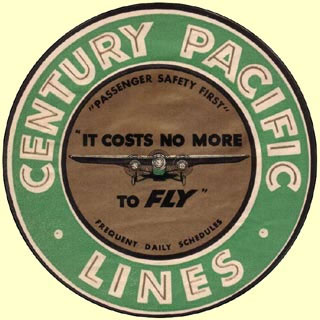 |
NC10810 appeared in the Grand Central Air Terminal (GCAT) Register over 50 times during June and July, 1931. As a new airplane, it was a liner in the employ of Century-Pacific, Ltd. It wore Century-Pacific Ltd. livery, left, and carried passengers, mail and freight along the west coast from San Diego to San Francisco. Century-Pacific was organized by Oxnard Field Register pilot E.L. Cord.
During 1932, Century-Pacific was absorbed into the workings of the American Airways sytem, thus American inherited some 24 SM-6000-Bs and other craft in the merger. American operated the Stinsons for about three years, then offered them for sale as used aircraft to the highest bidder. Photograph, below, courtesy of a site visitor, shows NC10810 on the ground in Blackwell, OK. The date is unknown (ca. 1935-36?), but it is after it was owned by Century Pacific, and American see below. The little girl became our visitor's wife. Blackwell Field became Blackwell-Tonkawa Municipal Airport and is operational today. I don't recognize the rearing horse (and rider?) livery on the fuselage.
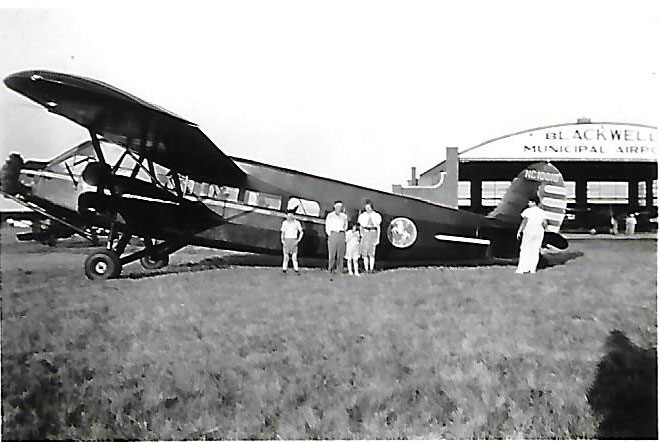 |
We can trace NC10810 through this series of exchanges, because, thanks to the generosity of a site visitor, we have the complete registration and airworthiness records for NC10810 from manufacture to final demise. Regarding the registration information, below, NC10810 was sold as a new aircraft on May 18, 1931 to Century Air Lines of Chicago, IL. As delivered from the factory, the Lycoming radial engine serial numbers were 490 (center engine), 493 (right) and 482. It had a normal life for a Golden Age airplane, meaning it worked hard and died young. Starting life as an airliner for two transport companies, it was sold to a barnstormer, then to an individual. It was destroyed by fire at age nine. The paper trail comprising the chain of custody follows. First, the bill of sale.
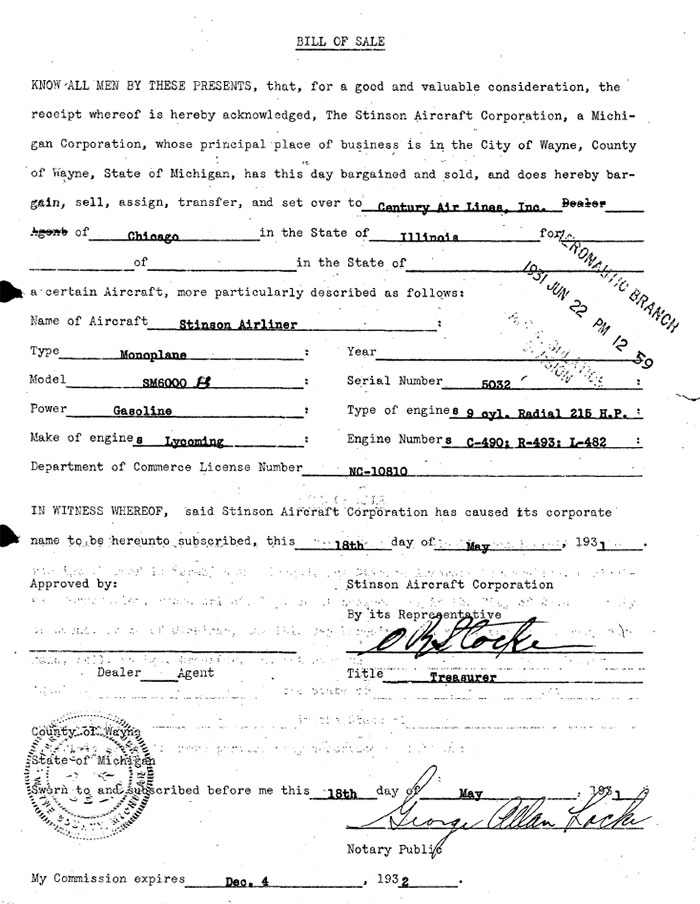 |
Two months later, on July 24th, the airplane was transferred to the west coast within the Century company to Century-Pacific Air Lines, Ltd., Glendale, CA. The transfer document is below. We now have NC10810 in the employ of Century-Pacific Air Lines, based at Glendale. Based on Register entries for June-July 1931, NC10810 was used for passenger transport in California before the date of the transfer: it took a while for the paperwork to catch up!
 |
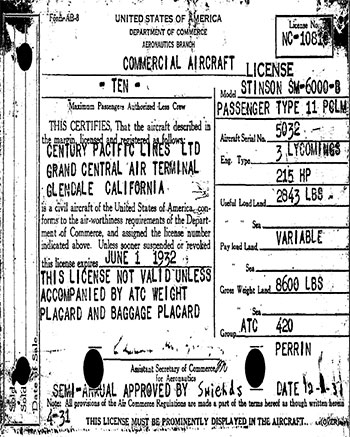 |
The registration card for the airplane was issued in December, left, with an expiration date six months later. The four-page inspector's report, dated December 1, 1931, which enabled the airplane to be registered, is at the link (PDF 440kB). By law this card had to be carried in the airplane at all times, along with specified weight placards for passengers and baggage.
As of 1932, Century-Pacific operated thirteen Stinson Model SM-6000-B aircraft, of which nine were recorded in the GCAT Register during 1931. They were NC10810, NC10813, NC10814, NC10840, NC10843, NC10844, NC10845, NC10846 and NC10847. Of these, our NC10810 appeared most frequently in the GCAT Register.
A three-page letter, below, from the Department of Commerce (DOC) dated February 25, 1932 clarified the registration currency of these airplanes (plus two Stinson Juniors used by the air line). Of real interest in this letter is a listing of the pilots employed (either full-time or part-time?) by Century-Pacific.
Frustratingly, no pilot information was noted in the Register by tower Operator A.J. Lygum or others that allowed us to associate particular pilots with any given flights by NC10810 or any of the other Century-Pacific Stinsons.
Only one of these fourteen listed pilots appeared by name in the GCAT Register. He was Harold Sweet who was recorded nearly 200 times giving scenic recreational rides in the Ford trimotor NC5577, which belonged to the Curtiss-Wright Flying Service. This activity was completely unrelated to Century-Pacific business.
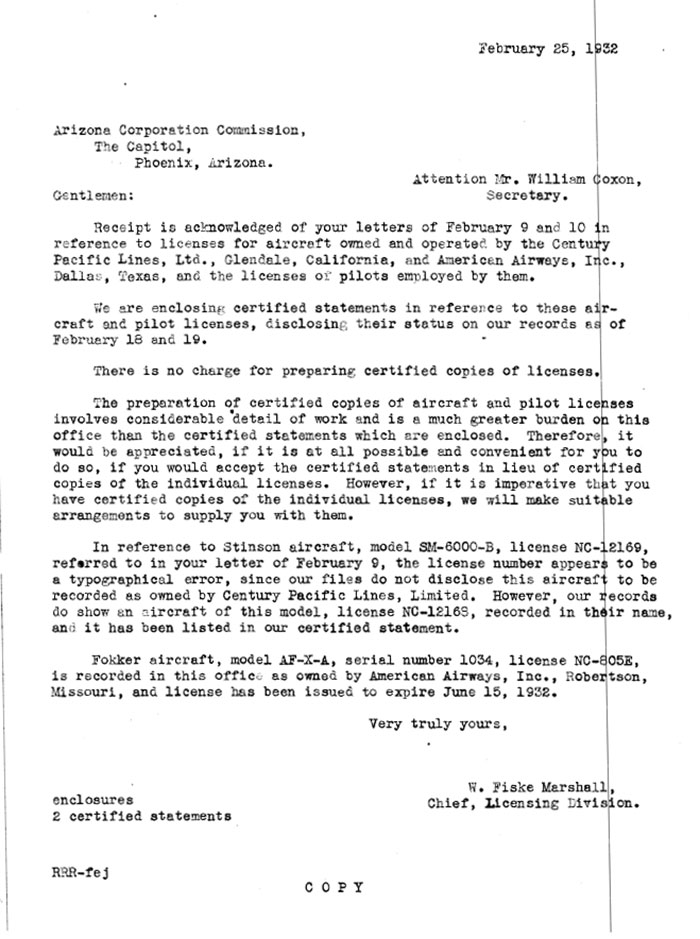 |
Some of the other pilots appeared in other Registers. For example, James L. Giffin appeared in the Davis-Monthan Airfield Register on November 14, 1931 flying the Stinson Jr. NC10866 operated by Century-Pacific. And Walton H. Smiley landed at Tucson November 16, 1931 flying the SM-6000-B NC10847. In addition, NC10872 and NC10893 were Register airplanes, visiting the Davis-Monthan Airfield on August 18, 1931, and between September 4 and 9, 1931, respectively, all within the period of Century-Pacific operations.
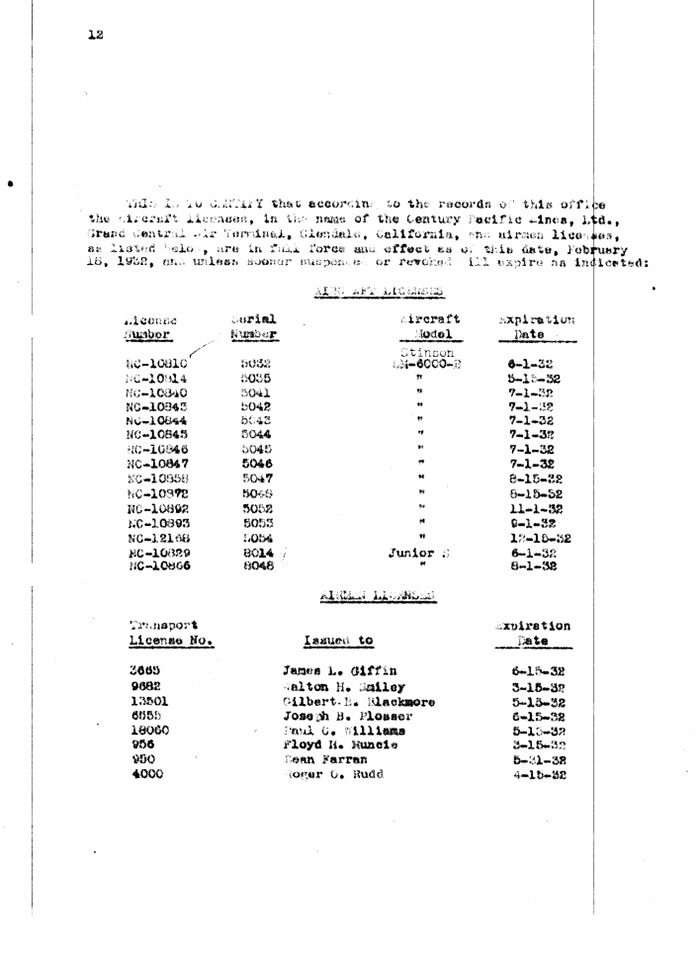 |
Likewise, Blackmore, Joseph Plosser, Williams, Muncie, Medler, Ben Catlin, Glennan, Robert Cantwell, and Erickson were signed in one or more Registers, some flying the Century-Pacific airliners.
 |
A film of a Stinson Model T taking off is at the link. In this film George Bernard Shaw provides color commentary. His airplane is NC11118, owned by the Hearst publishing company and a frequent visitor to GCAT. NC10810 was transferred to American Airway as of April 28, 1932 as documented in the letter below. According to another letter, the airplane was located in Chicago, IL at the time. All the other Century-Pacific Stinsons were transferred to American Airways over the next month.
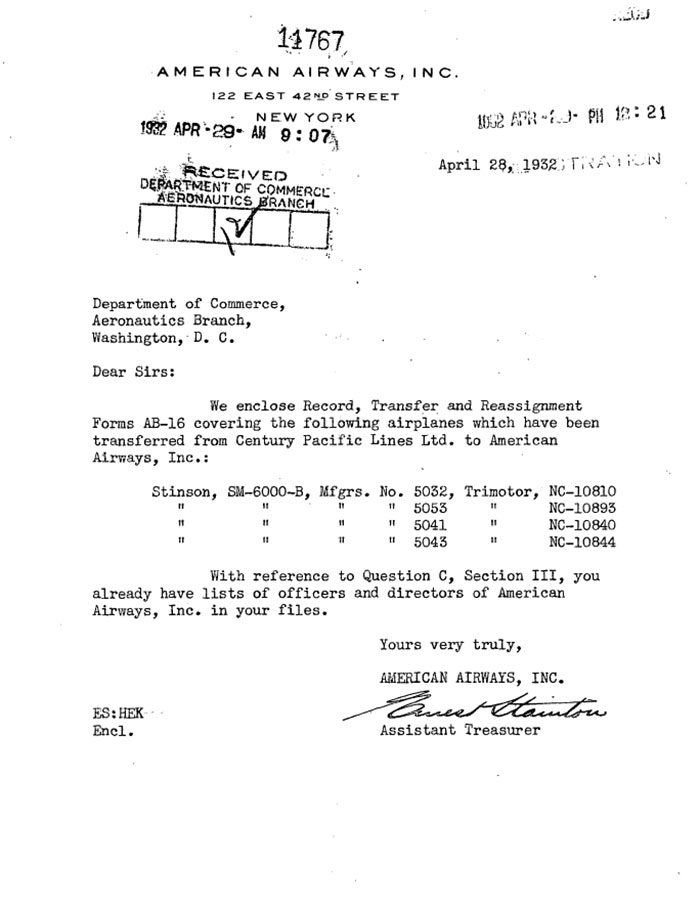 |
One of the first things American did was a thorough weight and balance calculation on their acquired aircraft. That two-page calculation for NC10810, dated June 29, 1932, is at the link (PDF 275kB). NC10810 was inspected by the DOC and judged fit to license in a letter to American dated August 8, 1932. NC10810 had accumulated 1,786 flight hours as of July, 1932. Given that it was 15 months old, that works out to an average of about 119 flight hours per month in passenger service. Over the next year, the airplane had accumulated 2,995 flight hours as of its routine inspection on June 14, 1933. That's an additional 1,209 flight hours in eleven months for an average of about 110 hours per month for 1932-33. On average, NC10810 had flown 3-4 hours per day over its life to June, 1933.
SPONSORED LINKS
In a letter dated May 1, 1934, NC10810 was identified as being in dead storage at Tulsa, OK, "until sold." Below, from March 2nd is a listing of aircraft for sale by American. The asking price for NC10810 was $5,000. There is an American Airways Model T still flying (not a Register airplane). You can view it at the link.
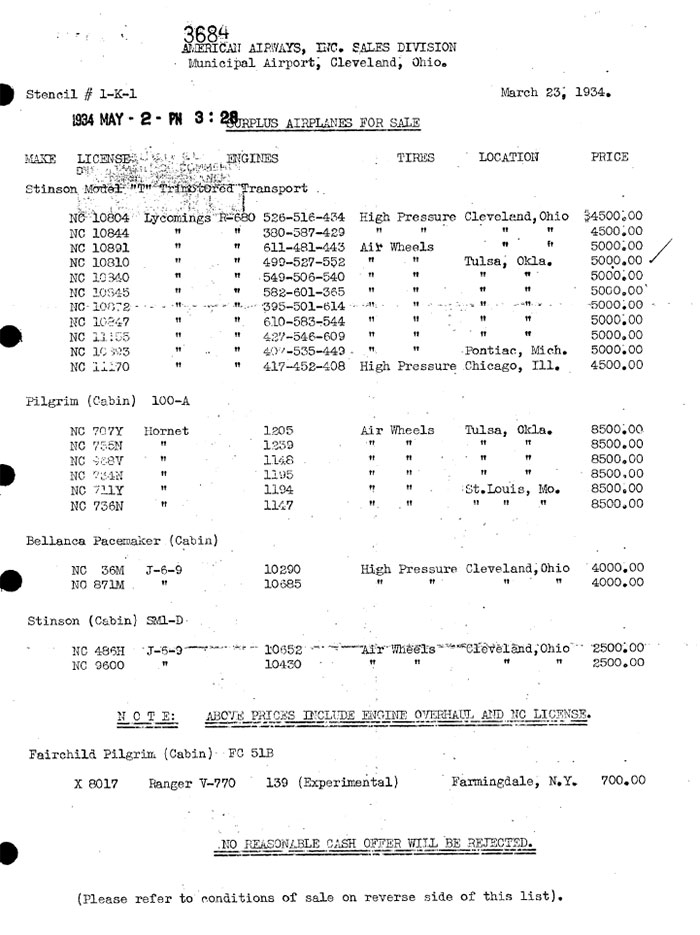 |
A little over a year later, NC10810 was sold by American to Field Flying Service of Tulsa, OK (E.A. Field and M.E. Pitcher, based at the Municipal Airport, Tulsa, OK). The record of transfer is below.
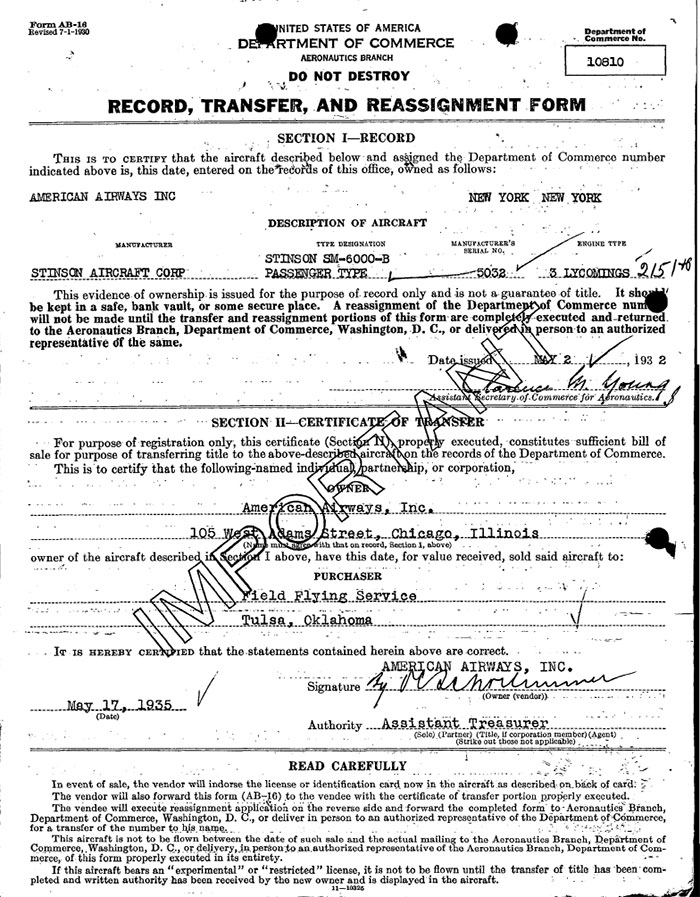 |
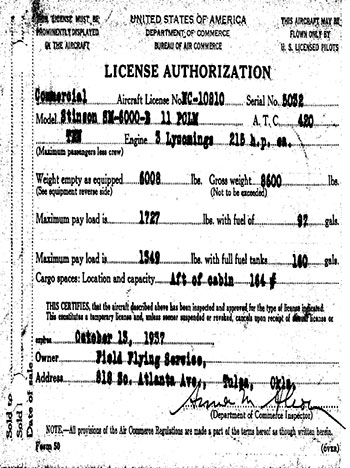 |
One of the first things Field Flying Service did to the airplane was remove the mail compartment and install three additional chairs, thus converting the airplane to its original passenger carrying configuration. It was so configured as of May 25, 1935. The airworthiness records for the airplane record the first inspection report issued to Field as May 15, 1936. A new registration was issued, to expire in 1937. In 1937 the registration card for the airplane now appeared in the Field Flying Service name, right.
Major refurbishment of the fabric and pigment coverings was performed as of June 19, 1937. The wing and fuselage fabrics were stripped and replaced. Fourteen coats of dope were sprayed and brushed on the wings. The fuel tanks were repaired at the Stinson factory and the interior was completely stripped and reupholstered. New control cables were installed for the rudder and ailerons. All this was performed by Claud Eure who held Aircraft & Engine Mechanic certificate 14443 (see below).
Refurbished, the airplane was out barnstorming later in 1937, and it was important that a current registration certificate be exhibited in the airplane for passengers to inspect. The certificate at right expired October 13, 1937 and a new certificate was forthcoming. When it did not arrive in a timely manner, owner E.A. Field wrote the following letter to the DOC expressing concern over the status of the new registration certificate. Field's letter was answered by the DOC on September 27th and the new registration card was enclosed with that letter.
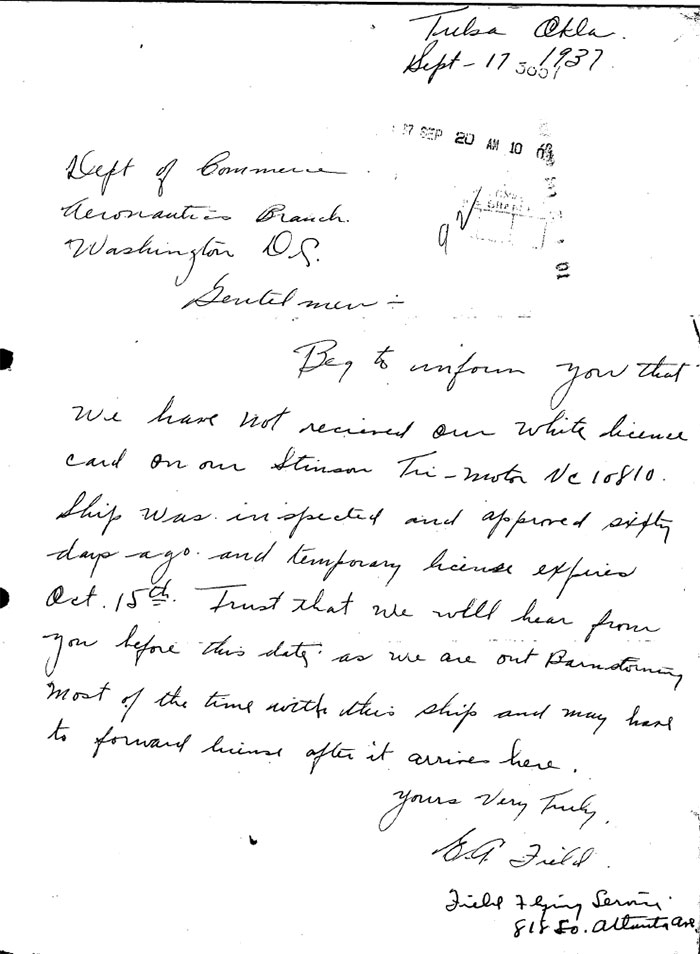 |
Shortly, Field Flying Service transferred the airplane to Claud C. Eure (Transport pilot T16481) of Fort Worth, TX on December 15, 1937. The record of transfer is below. As the mechanic, Eure, above, had performed significant maintenance on the airplane just a few months previous, so he know the airplane, literally, inside and out. Eure must have assumed title to the airplane via an extended payoff program, because Field Flying Service maintained a lien on it in the records.
 |
There is a gap in documentation for the airplane. In July, 1938, Eure moved to McAlester, OK and an address change form was part of the official record for the airplane. On July 7, 1939, he applied for registration of the airplane giving his address as the Tri City Airport, Goose Creek, TX. The airplane had accumulated 4,253 flight hours as of that date. If you do the math, thats about 532 hours per year over the eight years of its life, or about 44 hours per month. It's clear that Field and Eure did not fly the airplane as intensely as the airlines.
Eure applied for re-registration of NC18010 on July 30,1940 and it was re-registered. He flew the airplane on what was described on an inspection form as "local sightseeing flights." The record shows on October 2, 1940 the airplane suffered an accident at Belleville, TX. Eure was the pilot, carrying ten passengers. The accident report follows.
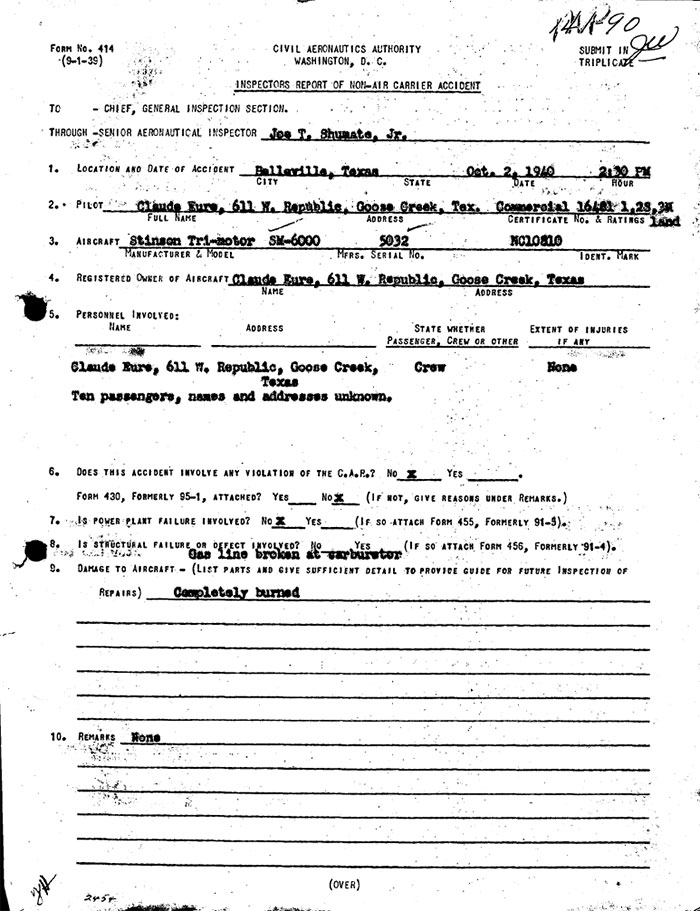 |
A fuel line broke and the airplane caught fire in flight. Eure landed successfully, unloaded all the passengers safely, they stood back and watched his airplane burn. The cause was suggested to be "poor maintenance."
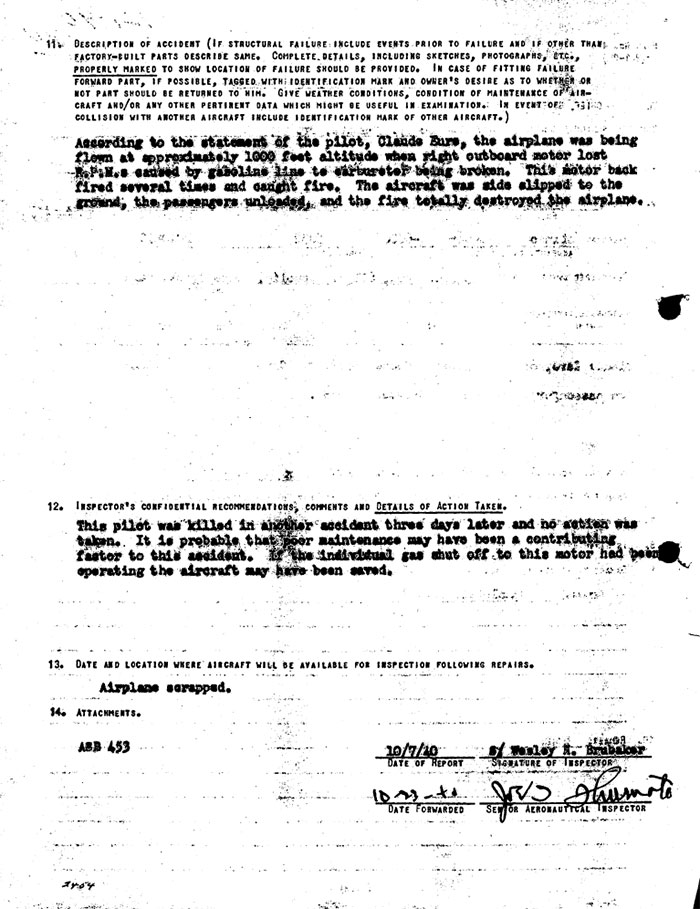 |
Eure was in the air again three days later in another airplane. An accident with that airplane killed him. The registration for NC10810 was cancelled the same day it burned, below.
 |
There are a half dozen other SM-6000-B Stinsons that landed at GCAT and at the Davis-Monthan Airfield that share similar histories. Refer to this airplane's sister ships at these links: NC10814, NC10815, NC10843, NC10845, NC10847, NC10872, NC10893.
Another moving picture of a flight in a restored Model T (1991) is at the link (also not a Register airplane). If you have photographs of NC10810 and would like to share them, please let me KNOW.
---o0o---
SPONSORED LINKS
THIS PAGE UPLOADED: 11/17/16 REVISED: 8/19/18
